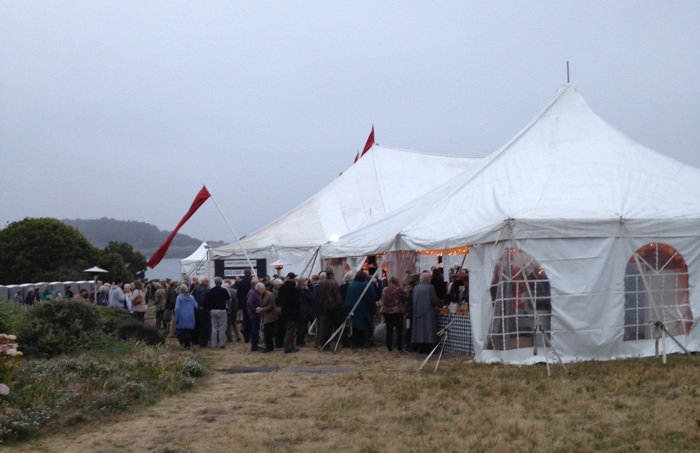In 1986 Allan Pollack, Susan Waterfall and Walter Green turned their vision for a North Coast music festival into reality. Drawing on their Bay Area musician friends, particularly from the SF Symphony and SF Opera Orchestra, their festival was an instant success. Set in a large striped tent on the headlands of Mendocino looking out over the ocean, they eventually moved into an even larger tent, which, at 16,000 square feet can comfortably hold a substantial orchestra and chorus along with 800 audience members.
On Wednesday, July 20, two weeks into this year’s festival, Pollack led two signature Beethoven pieces, the Violin Concerto and Symphony No. 3, the “Eroica,” or heroic (and yes, Beethoven’s middle works are called the “Heroic” period). Violinist David McCarroll stunned the audience with his sincerity and fire, and the sold-out audience gave a standing ovation.
This was an unusual rendition of a timeless work, meant to recreate the flavor of the original 1806 premiere, when violinist Franz Clement added his own flourishes to a cadenza between the first and second movements, even playing his violin upside down to titillate the crowd. One must remember that this music was the rock concert of its time, meant to directly inspire or outrage its audience. Beethoven opened his violin masterpiece with four timpani beats, throwing down a gauntlet and telling them that this is not your grandmother’s Mozart or Haydn.
The orchestra was delicate and tight, with crystal silences where one held one’s breath, and nimble in the triumphant fast passages of the ending. Their crescendos turned the phrases plush and rounded, and in their full-throated moments there was a sense of the measured tread of majesty that we associate with Beethoven’s greatness.
 McCarroll entered with a sweetness that was remarkable, and reminded one of the scalding notes of Joshua Bell or Nilolaj Znaider. In the first cadenza McCarroll delivered such an easy evenness of sound that we sensed he could have played it much faster. And then he did in one ferocious variation after another! And then he put some real dirt on his chords, and we were transported into the circus-like flair of that 1806 premiere, or perhaps to some violin version of Wrestle-mania, an outsized and athletic shout-out of life.
McCarroll entered with a sweetness that was remarkable, and reminded one of the scalding notes of Joshua Bell or Nilolaj Znaider. In the first cadenza McCarroll delivered such an easy evenness of sound that we sensed he could have played it much faster. And then he did in one ferocious variation after another! And then he put some real dirt on his chords, and we were transported into the circus-like flair of that 1806 premiere, or perhaps to some violin version of Wrestle-mania, an outsized and athletic shout-out of life.
In this and the following Eroica, the winds were electric, with clarinetist Eric Kritz delivering Beethoven’s nobility and oboist Thomas Nugent (known to Bay Area fans from the Left Coast Chamber Orchestra) giving us sumptuous depth. And the French horn harmonies were fat and fabulous, led by Bill Klingenhoffer and a cadre of respected horn players.
Tyler Mack played the timpani, the only percussion used in Beethoven’s era, and he not only opened the door and set the stage throughout, but turned bass passages fierce (and the basses, led by Michel Taddei, were already pretty fierce), and then accompanied McCarroll in a long solo cadenza. And McCarroll did NOT turn his 1761 Gagliano violin upside down, but he did play as if the ink were still wet on the page.
The second movement, brought out a theme of three notes stepping up a scale, imbuing the music with a hope that was unbearably tentative. Here bassoonist Carolyn Lockhart supported the high sweetness of violin with the cool presence of earth. And then they rocked the house with a reckless finale.
After the immediacy of that performance, the Eroica felt scattered. Indeed, the audiences of Beethoven’s era were confused by it, even though Beethoven remarked that it was his own favorite. His long variations would perhaps be helped by the icy focus of a Berlin Philharmonic… but they would probably not be playing in a tent! Nonetheless, the 800 audience members were riveted, and that sense that we were witness to such artistry in their own front yard was compelling.
More about the festival…
As time passed, the festival became more eclectic, no doubt in response to the musically diverse local population and largely due to the varied talents of Pollack and Waterfall. Along with composing and conducting the Festival Orchestra, Pollack is a clarinetist and sax man, and leads an evening of Big Band each summer. Waterfall, a trained pianist, also studied South Indian classical music, and has been the resident musicologist, narrating a multimedia music lecture series each summer. This year’s festival is themed around Beethoven, and that was the subject of five afternoon talks by Waterfall.
Now winding down its 30th summer, Mendocino is a model for mix-it-up music festivals, with 24 events featuring singers from Malawi and a complete Mozart opera, piano recitals and zydeco, and this year, lots and lots of Beethoven. The artists and orchestra members assemble each year from their home orchestras, with ninety of them housed by locals, a generosity that allows this festival to exist in a small but tight-knit coastal community.
—Adam Broner
Photo of the “big top” on the headlands.
